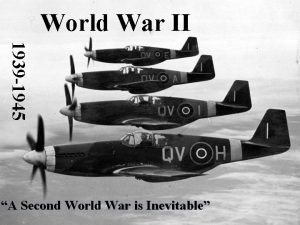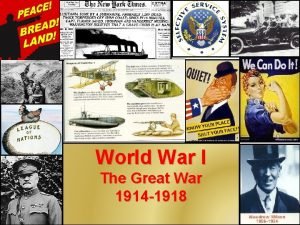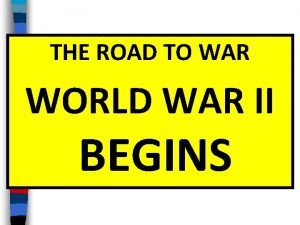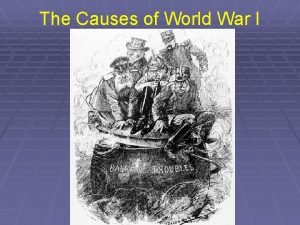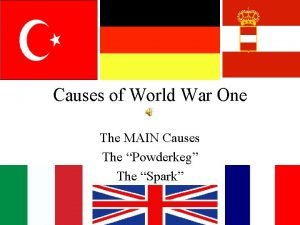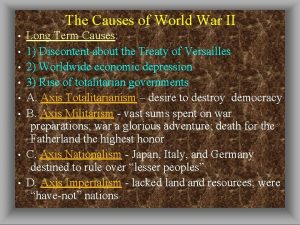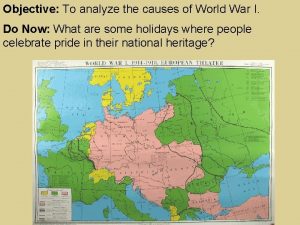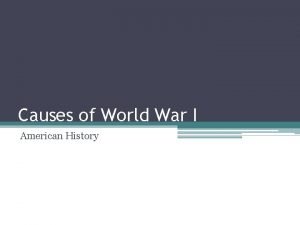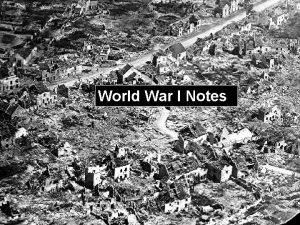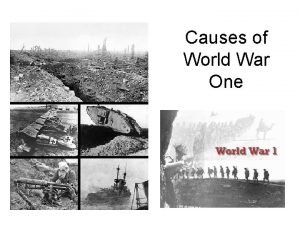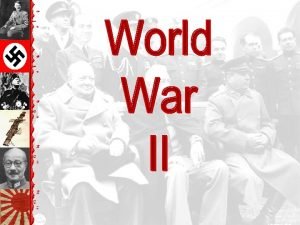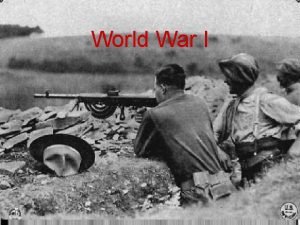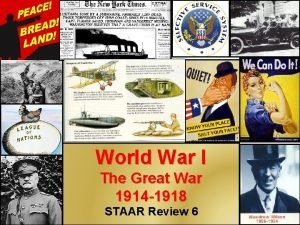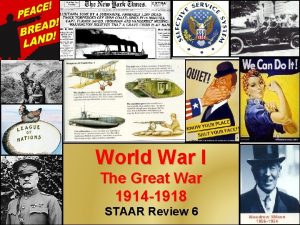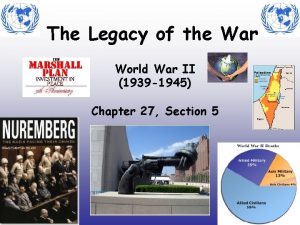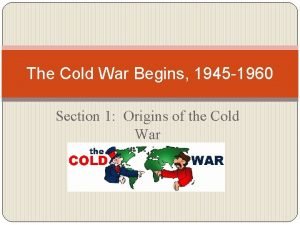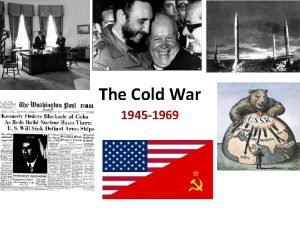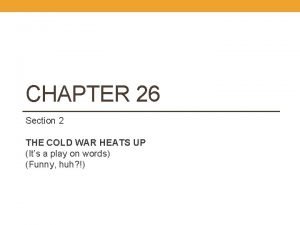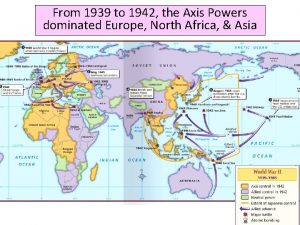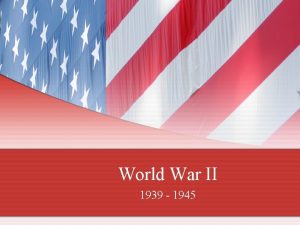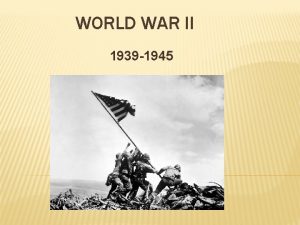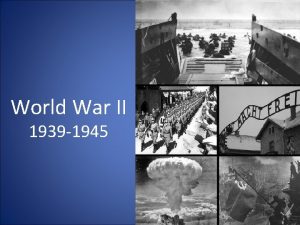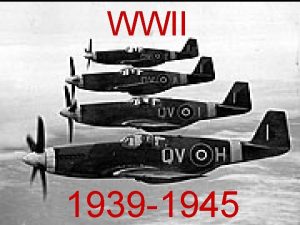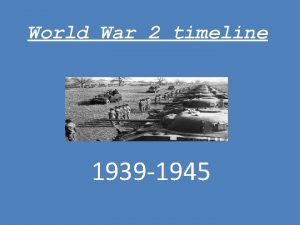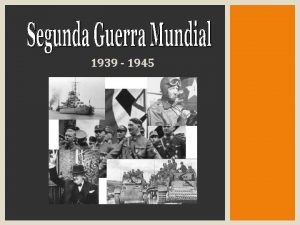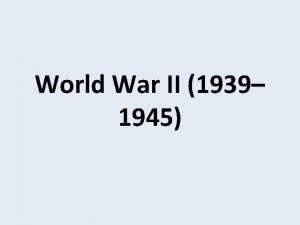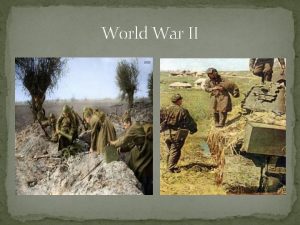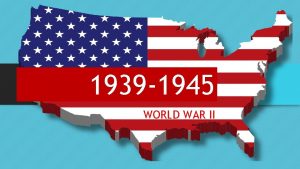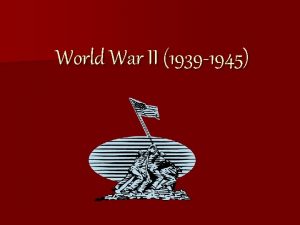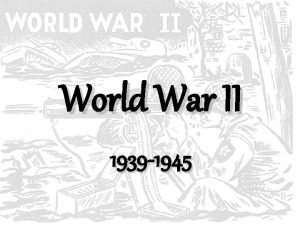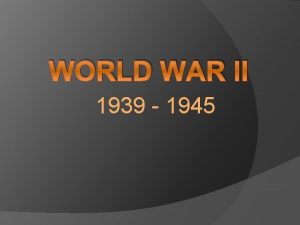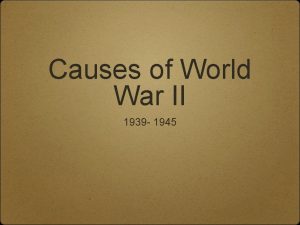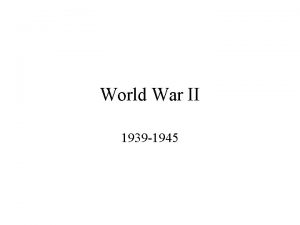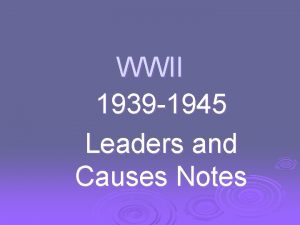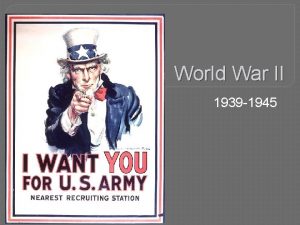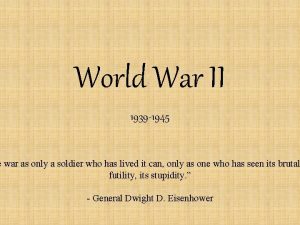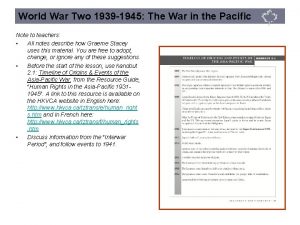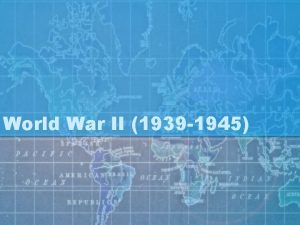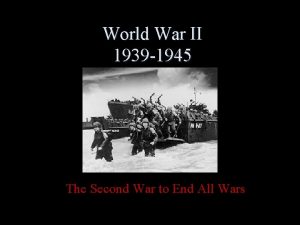World War II 1939 1945 I Causes A





























- Slides: 29

World War II (1939 -1945) • I. Causes – A. Totalitarianism. Governments that want total control of their citizens lives. These governments are usually controlled by a dictator. • 1. Two prime examples: – a. Adolf Hitler Background- Hitler lost his father when he was a young child. As a young man he entered art school and later became a soldier during WWI. Hitler took power in 1933 through his Nazi party. Hitler began to take control of Germany by force. Pro World War I rally in Austria

– b. Joseph Stalin- Stalin first came to power in 1925. Stalin took power of Russia after Vladimir Lenin died and quickly knocked off his rivals. By the time Stalin died, he had killed 10 -20 million Russians.

– B. Fascism- The belief that the government is more important than individual citizens. • 1. Benito Mussolini came to power in 1922 and was an ally of Hitler. In 1934, Mussolini attacked Ethiopia and by 1936 Ethiopia was annexed by Italy.

Allied propaganda of Mussolini – C. Imperialism- The desire of one nation to control and conquer another nation for their natural resources. • 1. Emperor Hirohito- In 1931, Japan attacks Northern China for its natural resources. – a. Quarantine Speech (Oct. 5 th, 1937) Roosevelt state that Japan, Italy, and Germany should be treated like a disease that other nations need to stay away from (I. e. Roosevelt wanted to quarantine these nations). Emperor Hirohito in traditional Japanese clothes

• II. Events Leading up to the War – A. Hitler annexes Austria On March, 12, 1938. In October, 1938 Hitler moved his troops into Czechoslovakia. – B. Munich Pact Neville Chamberlin, the Prime Minister of England, wanted to appease (make happy) Hitler. On September 30, 1938 Italy, France, England Germany signed the Munich Pact which let Germany invade the Sudetenland a province that was part of Czechoslovakia.

– C. Nazi-Soviet Non. Aggression Pact (Aug. 23, 1939) Stalin and Hitler signed a peace treaty which divided up Poland between Russia and Germany. In addition, Stalin and Hitler promised not to attack each other. Hitler betrays Stalin in 1941 and launches Operation Barbarosa (The invasion of Russia).

• III. The War Begins – A. The Invasion of Poland (Sept. 1, 1939) After the Nazi Soviet Non -Aggression Pact, Hitler marched his armies into Poland. Hitler used a new military tactic called the Blitzkrieg (lightning war) in which ground troops and the air force were united in the attack. Soviet (Russian) and Nazi troops meet to discuss how to conquer Poland.

– B. The Fall of France (June 22, 1940)- After Hitler conquered the Netherlands (Holland) and Belgium, his Nazi troops were able to conquer France in three weeks.

– C. The Battle of Britain (Summer to Fall 1940) This battle was fought in the air and not on land. Although Hitler’s air force bombed England for over two months, England never gave up and forced Hitler to postpone his attacks. • 1. Winston Churchill. Prime Minister of England during WWII. Churchill was instrumental in encouraging the British people not to give up or surrender to Germany. • 2. Royal Air Force. Although the British air force was overmatched they fought on and were able to win “dogfights” over the Luftwaffle.

• IV. The U. S. Enters the War – A. Lend-Lease- The U. S. lends or leases military arms/equipment to allies fighting Germany, Italy, and Japan (Axis Powers). – B. Germany begins sinking American ships with their submarines. The Germans use a “wolfpack” strategy. America remains neutral. – BBC - History - Battle of the Atlantic game

– C. Pearl Harbor (Dec. 7 th, 1941) Japanese bombers attack America’s Pacific Fleet and destroy 5 battleships and 170 airplanes. Over 2, 400 men loose their lives – National Geographic: Remembering Pearl Harbor-history, maps

• 1. Effects of Pearl Harbor – a. The U. S. is united in its desire to defeat the Axis Powers (especially Japan). – b. Japan had awakened a “sleeping giant”. The U. S. mobilized for the war by hiring over 18 million workers (6 million women).

– D. Battle of Midway (June 1942) The US is able to stop Japan from taking the tiny island of Midway. Importance: Midway stops the Japanese advance. – E. The Battle of Guadalcanal (Aug. 1942) The US captures Guadalcanal and wins a very important naval battle in the Pacific.

Gen. George Patton Gen. Dwight D. Eisenhower – F. Operation Torch Under the leadership of Dwight D. Eisenhower and George Patton, the U. S. and British attack German troops in Northern Africa. The U. S. succeeded in pushing back German troops.

– G. D-Day (Operation Overlord) June 6 th, 1944 - The allies amphibious (land sea) operation in France is the largest in history. Although the allies lost thousands of men, they were able to overtake German posts. The allies soon took over France, Belgium, Luxemburg and parts of the Netherlands.

– H. Battle of Leyte Gulf and the Philippines (Oct. American POW’s taken by 1944) The U. S. is able to the Japanese in the destroy most of the Philippines are taken on Japanese naval fleet and a “death march” take the Philippine islands. – I. Kamikaze Airplane Attacks- After the Japanese were badly beaten in the Philippines, Japanese pilots would use their planes as bombs when attacking American naval ships. Question: Is this heroic or stupid? Kamikaze attack of aircraft carrier

– J. Battle of the Bulge (Dec. 1944)- Germany launches a massive counterattack on allied forces. The Germans were successful at first, but the Germans were pushed back once the weather cleared for bombing raids. – K. Russian and American forces meet at the Elbe River in Germany. Germans fled desperately to the American lines to escape the Russians. – L. V-E Day (Victory in Europe)-After Hitler commits suicide on April th, 1945, Crowds celebrating the end of WWII 30 Germany surrenders on May

– M. Japanese Internment Camps. During World War II, the U. S. was afraid that Japanese in the U. S. would plan acts of sabotage. The Japanese were sent to camps in which they lost their businesses and freedom. Dust storms at the Manzanar Relocation Camp in California

• N. The Manhattan Project This project was headed by J. Robert Oppenheimer under topsecurity and carried out mostly at Los Alamos, New Mexico. – 1. Hiroshima and Nagasaki (Aug. 6 th, 1945) The first bomb was dropped on Hiroshima, an important military center killing over 71, 000 people and then on Nagasaki killing 36, 000 people. Japan surrenders on August 14 th, 1945. Question: Should the U. S. have dropped the bomb?

• V. The Holocaust – A. A Brief History of Anti-Semitism • • Nazi propaganda of a Jew Definition: Anti-Semitism- Prejudice against the Jewish race. 1. Treatment of the Jews in Europe during the 1800’s and 1900’s. – a. Europeans, especially in Germany, began to feel that they were superior to the Jews. » Eugenics Movement- People began to believe that: 1. Some races were superior to others 2. Certain traits are passed down from one generation to the next. 3. Sex between “superior” and “inferior” races should be avoided. 4. Science can help determine who is “superior” and who is “inferior”.

• 2. Jews were persecuted throughout Europe, especially in Russia where Jews feared Pogroms (armed attacks by angry mobs in Russia. ) • 3. The Nuremburg Laws (Germany) – 1. Jews must be able to serve the German people. – 2. Jews were restricted to where they could live and work. – 3. Germans could take away (confiscate) Jewish property. Angry mobs attacking Jews in Russia

• 4. Kristallnacht. Translated into English it means “Night of the broken glass”. In Nov. 1938 Jewish stores, synagogues, and homes were vandalized and destroyed. • 5. Gypsies, homosexuals, and the elderly began to be targeted as well as the Jews. – Euthanasia This term means peaceful death, but it is often referred to when the elderly are put to death.

– B. Hitler’s “Final Solution” • • • Key Term: Genocide-The systematic destruction of an entire race. 1. Hitler’s first step in annihilating the Jews was to force them into Ghettos (separate sections of various cities). 2. Hitler and his leadership then met to decide a better way of killing Jews, especially after his mobile killing units (The Eistatzguppen) began complaining of the psychological toil on them. Jews are then transported on an extensive railroad network organized by Adolf Eichman.

• 3. Once the Jews arrived at the concentration camps, they would be separated into two lines. Most Jews were then gassed and then thrown into ovens. Auschwitz is the largest and most notorious death camp.

• 4. Nazi soldiers would torture the inmates. Example: Dr. Mengele, known as the “Angel of Death”, would conduct This man tried to escape medical experiments at but was torched by the Nazis and left as a reminder the death camps. to other inmates. Mengele escaped to Brazil. • 5. Many Jews felt it was better to die than live through the torture. They would commit suicide by running into an electric fence, strangling themselves, and even drowning themselves in human excrement.

– C. Resistance to the Holocaust • 1. Most people refused to rebel because of the Nazi policy of Collective Responsibility was when the Nazis held the entire community responsible for the acts of an individual. • 2. Warsaw Ghetto Uprising. When the Nazis began to deport Jews from Warsaw in the summer of 1942, many Jews there called for open resistance. The Jews held out until May 1943 before they were either killed or sent to concentration camps. • 3. Sobibor- The Jews at this camp decided to rebel,

– D. People who saved the Jews Rauol Wallenburg Corrie Ten Boom’s house where her family hid the Jews in a secret room. • 1. Anne Frank- Her family hid Jews. Anne Frank was sent to a concentration camp and later died. • 2. Corrie Ten Boom-She was a Christian who hid Jews in her home. She was sent to a concentration camp where she died. • 3. Oscar Schindler. Creatively saved Jews by giving them jobs in his factory and by transporting them to his native town in Czechoslovakia. • 4. Raoul Wallenburg. This Swedish diplomat was able to save over 100, 000 Hungarian Jews. He later disappeared and

• V. The Aftermath of WWII – A. Yalta Conference (Feb. 1945)- Stalin, Churchill, and Roosevelt (The Big Three) met to decide the outcome of the war. The three agreed that German and Japanese leaders should be tried (Nuremburg Trials). Stalin promised that Poland would have free elections. – B. Roosevelt Dies/Truman becomes President After Roosevelt dies, Harry Truman becomes president and goes to Potsdam, Germany to meet Stalin refuses to let any of the Eastern European countries have free

– C. Nuremburg Trials. German and Japanese leaders are put under trial. The charges include; 1) Waging aggressive war 2) Violating the human rights of people. – D) United Nations- (June 1945) Designed to prevent future wars and bring about a better world, the U. N. is founded and built in New York. The U. N. is made up of a general assembly and the Security Council- Five permanent nations hold the most power. These nations include: France, England, Russia, The U. S. and China.
 1945 world war ii
1945 world war ii 1945 world war
1945 world war Main causes of ww1
Main causes of ww1 Ww2 causes
Ww2 causes Long term causes of world war 2
Long term causes of world war 2 Main wwi
Main wwi Long term causes of ww2
Long term causes of ww2 Causes of world war 1 mania
Causes of world war 1 mania Causes of world war 1 mania
Causes of world war 1 mania Wwi gas warfare
Wwi gas warfare Ww1 cause
Ww1 cause What caused ww2
What caused ww2 Causes of world war 2
Causes of world war 2 Ww1 main causes
Ww1 main causes Major cause of ww1
Major cause of ww1 Causes of world war 1
Causes of world war 1 Causes of world war 2
Causes of world war 2 The cold war begins 1945-1960
The cold war begins 1945-1960 The cold war heats up: 1945 - 1969
The cold war heats up: 1945 - 1969 Chapter 26 section 2 guided reading the cold war heats up
Chapter 26 section 2 guided reading the cold war heats up Proximate cause and ultimate cause
Proximate cause and ultimate cause Polygyny in animals
Polygyny in animals Italy population 1939
Italy population 1939 1930-1939 fashion
1930-1939 fashion Revolutionary leaders 1900-1939
Revolutionary leaders 1900-1939 Poland population 1939
Poland population 1939 Varför kallas perioden 1918-1939 för mellankrigstiden?
Varför kallas perioden 1918-1939 för mellankrigstiden? The golden age (1939-1956)
The golden age (1939-1956) Harta germaniei 1939
Harta germaniei 1939 Who dominated europe, north africa and asia from 1939-1942?
Who dominated europe, north africa and asia from 1939-1942?
